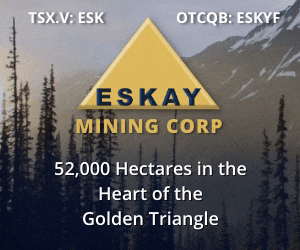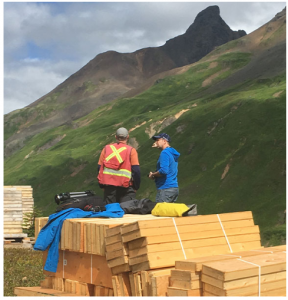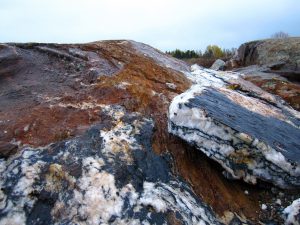Great Canadian gold camps: untapped gold deposits still awaiting discovery

By Ellsworth Dickson
Canada is noted for its rich gold camps that have produced huge quantities of the yellow metal that generated wealth for the country, opened up vast wilderness regions and provided countless employment opportunities.
The legendary Timmins Gold Camp in northeast Ontario has produced some 172 million ounces of gold, while across the border in Quebec, the Val d’Or Gold Camp has produced about 100 million ounces of gold. In northwest Ontario, exploration activity is heating up in the Red Lake Gold Camp where 30 million ounces of gold has been produced from 13 mines.
In a different kind of gold camp, the extensive Golden Triangle of northwestern British Columbia has seen more than 130 million ounces of gold, 800 million ounces of silver and 40 billion pounds of copper discovered.
Geologically speaking, how were these world-class gold camps created and what do they offer mining stock investors? To find out, Resource World interviewed Nanaimo, British Columbia-based independent consulting geologist Jacques Houle, P.Eng.
What kind of mineralizing event or events would create great Canadian gold camps such as Timmins, Red Lake and Val’d’Or?
Timmins, Red Lake and Val’d’Or are similar gold camps in several ways. The host rocks and gold mineralization are both of Archean age (2 to 3 billion years), all within the Abitibi Greenstone Belt of Ontario and Quebec. The camps are located along major, steeply-oriented fault zones which have been repeatedly reactivated over time and locally injected by multiple gold mineralizing events.
The gold quartz vein-style of mineralization is often with long vertical depth extents that have been compressed horizontally into relatively small areas. The deep erosional level of bedrock that was caused by massive glaciation are now overlain by recent glacial sediments.
The gold deposits in the BC’s Golden Triangle region extend for about 300 km north to south. Why is this gold camp so extensive?
BC’s Golden Triangle is quite different from the Abitibi gold camps in several ways. Host rocks and gold mineralization are of much younger Mesozoic age (50 to 250 million years), mainly within the Stikine Terrane of northwest BC.
Mineralization is associated with multiple intrusive events and related porphyry copper-gold deposits with both steeply and shallowly-oriented fault zones spread over relatively large areas. There are multiple styles of copper and/or gold mineralization, mainly porphyry and epithermal, with variable vertical extents but many deposits remain untested at depth. There is a shallow erosional level locally exposed in rugged, mountainous terrain.
Would you say that it lessens an investor’s risk to target companies exploring in established gold camps with known geology as opposed to individual projects all by themselves?
The more established gold camps have to date yielded those deposits that were the easiest to find, with the more difficult ones yet to be found in the future, mainly at greater depths from surface or greater distance from known deposits. Mineral deposits, including gold-bearing types, tend to occur in clusters with major gold camps containing a few large and many smaller deposits. Therefore, explorers and investors should target large projects with appropriate geological characteristics located within such deposit clusters as soon as possible after the first large deposit is discovered in the cluster.
Despite millions of ounces of gold already recovered from the four gold camps noted above, we are seeing much exploration activity taking place at those locales. This tells me that explorers must believe there are substantial gold resources yet to be discovered, again testifying to the huge mineralizing events. Is that correct and what is your view as to the remaining prospectivity of these camps?
It is physically impossible to completely exhaust the mineral resources in a gold camp through mining – there are always resources and exploration potential left behind after every mine is closed. Increases in gold prices, new exploitation technology, and new concepts or knowledge can rekindle interest, investment, exploration and discovery in any gold camp whether long-established or recently discovered.
 Mountain Boy Minerals Ltd.‘s [MTB-TSXV; M9UA-FSE] exploration program this summer includes drilling three targets on one of its British Columbia Golden Triangle projects. This explorer has four projects in the region with property spanning 340 km2 (34,000 ha). Three of those projects will be explored with the focus on the American Creek Project 22 km north of the port of Stewart. MTB’s claims are road accessible, 7 km from a paved highway and power.
Mountain Boy Minerals Ltd.‘s [MTB-TSXV; M9UA-FSE] exploration program this summer includes drilling three targets on one of its British Columbia Golden Triangle projects. This explorer has four projects in the region with property spanning 340 km2 (34,000 ha). Three of those projects will be explored with the focus on the American Creek Project 22 km north of the port of Stewart. MTB’s claims are road accessible, 7 km from a paved highway and power.
The MTB property includes the high-grade Mountain Boy silver mine, which operated in the early 1900s. Multiple previous operators explored parts of the property. After present management consolidated an extensive property position, the geological team assembled data and, for the first time, looked at it on a comprehensive basis and added results from two field seasons.
The new geological model is similar to the geological setting for the Premier camp just over the mountain to the west. Premier was one of the most important gold mining camps in BC and will again see production.
The high-grade production from the old Mountain Boy mine, the multitude of showings throughout the property and the close analogy to Premier support MTB’s belief that its property has potential to host gold-silver deposits similar to those at Premier that saw 70 years of production.
Drilling will target the down-dip extension of a 2006 drill hole at the mine which encountered 5 kg silver over 5 metres. Drilling will also test six other known veins at the mine. The second target is the northward extension of those veins onto the recently optioned Dorothy property. The third target is a new discovery made by MTB. While examining the newly-optoned Silver Crown property, the MTB team mapped an extensive alteration zone that recently emerged from glacial cover. Surface samples included 28 g/t gold and 1,200 g/t silver.
Drilling success at any of these targets would be an important discovery.
 Eskay Mining Corp. [ESK-TSXV; ESKYF-OTC; KN7-FSE] controls approximately 52,600 hectares of prospective mineral properties in the heart of northwestern BC’s prolific Golden Triangle region.
Eskay Mining Corp. [ESK-TSXV; ESKYF-OTC; KN7-FSE] controls approximately 52,600 hectares of prospective mineral properties in the heart of northwestern BC’s prolific Golden Triangle region.
Located about 70 km northwest of the port of Stewart, the properties have compelling structural settings with multiple underexplored precious metal-rich VMS prospects that have high-grade gold targets and copper-gold porphyry potential.
The company’s land package is literally surrounded by major precious metal-rich VMS deposits, including Seabridge’s KSM Project, Pretium’ producing Brucejack Mine and Barrick’s past-producing Eskay Creek Mine. The famous Eskay Creek Mine had production of 3.3 M oz gold and 161 M oz silver at 45.57 g/t gold and 2,231 g/t silver.
Eskay Mining has an 80/20 joint venture with Kirkland Lake Gold on the northern portion of the claim group. Recent interpretation of historic drilling at the SIB property, part of the Kirkland Lake JV, demonstrated strong potential for discovery of extensions of the Eskay Creek VMS system.
 Eskay Mining controls approximately 85% of the local terrane considered prospective for Eskay Creek-style precious metal-rich VMS deposits. With new operators, the past-producing Eskay Creek Mine has an estimated combined Indicated and Inferred 4 million-ounce 4.4 g/t gold-equivalent open-pit resource.
Eskay Mining controls approximately 85% of the local terrane considered prospective for Eskay Creek-style precious metal-rich VMS deposits. With new operators, the past-producing Eskay Creek Mine has an estimated combined Indicated and Inferred 4 million-ounce 4.4 g/t gold-equivalent open-pit resource.
At the 100%-controlled Cory property in the southern part of the claim group, recent exploration has revealed multiple Eskay Creek-style VMS targets as well as evidence of porphyry copper-gold systems similar to the adjacent KSM deposit.
Other prospects on the company’s land package are very prospective for VMS deposits, including the TV/Jeff, TET and Cumberland prospects. At Jeff, the best historic drill intercept was 3.7Â g/t gold over 43.55Â metres.
A 3,000-metre diamond drilling is underway with most holes testing the TV and Jeff VMS prospects.
Eskay Mining as about $4 million in cash and 130,264,962 shares outstanding.
 Aben Resources Ltd. [ABN-TSXV; ABNAF-OTCQB; E2L-FSE] is following up on last year’s encouraging exploration results at the 100%-owned Forrest Kerr gold project in the heart of BC’s Golden Triangle region. Numerous areas of interest have been identified since the company began systematic exploration in 2016, with a total of 70 drill holes (21,968 metres) completed to date.
Aben Resources Ltd. [ABN-TSXV; ABNAF-OTCQB; E2L-FSE] is following up on last year’s encouraging exploration results at the 100%-owned Forrest Kerr gold project in the heart of BC’s Golden Triangle region. Numerous areas of interest have been identified since the company began systematic exploration in 2016, with a total of 70 drill holes (21,968 metres) completed to date.
Exploration over the last few years at Forrest Kerr focused on two primary zones: the North Boundary Zone running parallel to the Nelson Creek Fault zone, and the South Boundary Zone, which runs parallel to and extends south along the Benchlands Fault zone. This new Benchland Fault Zone extends south another 500 metres and is highly mineralized. The appearance and tenor of mineralization appears the same as that found in the South boundary holes.
The road-accessible Forrest Kerr property, which has power available, consists of four separate claim blocks comprising 56 mineral claims (23,397 hectares).
Surrounding the project are notable mineral deposits and producing mines including Pretium’s Brucejack Mine, the past-producing Eskay Creek and Snip mines as well as advanced projects including Galore Creek, Copper Canyon and Red Chris.
An exploration camp has been established and groundwork is underway. Initial fieldwork comprises mapping, prospecting, soil sampling and rock sampling to better define existing targets and generate new targets for the current permitted drill program.
 The initial area of focus will be on the west bank of the Boundary Valley, roughly 500 metres south of the high-grade mineralized zone at North Boundary. This area is host to a 300-metre-long corridor of polymetallic mineralization that has returned gold grades ranging from 10 to 43.4 g/t gold, 29.2 to 46 g/t silver and 1.3% to 4.6% copper in multiple rock samples from outcrop. Drill hole FK19-53 intersected a mineralized horizon 110 metres directly below these surface samples averaging 1.2 g/t gold, 2.4 g/t silver and 0.3% copper over 19 metres that demonstrated the continuity of mineralization over a significant vertical extent. The gold-silver-copper mineralization and alteration in drill hole FK19-53 core closely resembles mineralization discovered by Aben at the North Boundary Zone. This leads to the possibility that this new zone may have slip faulted away from the North Boundary as it is on the other side of the Nelson Creek Fault.
The initial area of focus will be on the west bank of the Boundary Valley, roughly 500 metres south of the high-grade mineralized zone at North Boundary. This area is host to a 300-metre-long corridor of polymetallic mineralization that has returned gold grades ranging from 10 to 43.4 g/t gold, 29.2 to 46 g/t silver and 1.3% to 4.6% copper in multiple rock samples from outcrop. Drill hole FK19-53 intersected a mineralized horizon 110 metres directly below these surface samples averaging 1.2 g/t gold, 2.4 g/t silver and 0.3% copper over 19 metres that demonstrated the continuity of mineralization over a significant vertical extent. The gold-silver-copper mineralization and alteration in drill hole FK19-53 core closely resembles mineralization discovered by Aben at the North Boundary Zone. This leads to the possibility that this new zone may have slip faulted away from the North Boundary as it is on the other side of the Nelson Creek Fault.
At the North Boundary High-Grade Zone, Hole FK-18-10 returned 38.7 g/t gold over 10 metres from 114 to 124 metres, including 331 g/t gold over 1.0 metre, from hole FK18-10 as well as 22 g/t gold and 22.4 g/t silver over 4.0 metres from 84 to 88 metres. Hole FK17-04 returned 6.7 g/t gold, 6.4 g/t tonne silver and 0.9% copper over 10 metres, including 18.9 g/t gold, 16.6 g/t silver and 2.2% copper over 3.0 metres. Hole FK17-05 returned 21.5 g/t gold, 28.5 g/t silver and 3.1% copper over 6.0 metres.
This mineralized corridor is west of the Nelson Creek fault, previously thought to cut off the polymetallic mineralization found east of the Nelson Creek fault at North Boundary. A large and untested magnetic anomaly is located 190 metres west of the mineralized trend in a scree-covered area with little outcrop present. The coincident magnetic anomaly, combined with the confirmed precious metal mineralization in both outcrop and drill core from this area, makes for a compelling target that will be further explored this season.
Jim Pettit, President and CEO of Aben Resources, stated: “We are pleased to be back up at the Forrest Kerr Project and have utilized the off-season to work up some site-specific targets based on detailed drill analytics, surface sampling and geophysical analysis from the past three years. Initial work this year will involve further ground truthing targets and drilling. We will start in an area that has an abundance of high-grade mineralization in outcrop that is coincidental with downhole mineralization directly below the surface samples. This is basically the process we used to discover the high-grade gold zone at North Boundary.”
 Midland Exploration Inc. [MD-TSXV], a prospect generator style of exploration company that has several gold prospects along the prolific Abitibi Gold Belt that runs west from Val d’Or, Quebec across the Ontario border and past Timmins.
Midland Exploration Inc. [MD-TSXV], a prospect generator style of exploration company that has several gold prospects along the prolific Abitibi Gold Belt that runs west from Val d’Or, Quebec across the Ontario border and past Timmins.
All of Midland’s projects are in Quebec and over a dozen are north of the belt in a region noted for many significant gold deposits. The company’s other projects are located in the James Bay region of far northern Quebec and the Labrador Trough (Nunavik) which are mainly gold and base metal projects.
In addition to its 100%-owned properties, Midland favours the joint venture model to advance mineral prospects and has agreements with Agnico Eagle Mines, Wallbridge Mining Company, Probe Metals, Osisko Mining, Abcourt Mines, SOQUEM and NMEF (Nunavik Mineral Exploration Fund). Midland is one of the biggest land holders in the Detour Trend near the Wallbridge-Balmoral discovery.
 Exploration has resumed on Midland’s 100%-owned Mythril and Mythril regional projects in the Eeyou Istchee James Bay region of northern Quebec. The summer program includes a lake sediment survey, prospecting and reconnaissance campaign. Prospecting is targeting newly defined lake sediment anomalies as well as copper-gold-molybdenum and gold occurrences and boulder fields discovered in 2019.
Exploration has resumed on Midland’s 100%-owned Mythril and Mythril regional projects in the Eeyou Istchee James Bay region of northern Quebec. The summer program includes a lake sediment survey, prospecting and reconnaissance campaign. Prospecting is targeting newly defined lake sediment anomalies as well as copper-gold-molybdenum and gold occurrences and boulder fields discovered in 2019.
Midland recently signed a joint venture agreement with Probe Metals encompassing 125 km2 that includes Midland’s Gaudet and Samson NW properties and Probe’s Fenelon-Nantel property.
The company is drilling its 100%-owned Samson gold project 15 km southeast of the Fenelon and Tabasco deposits held by Wallbridge.
Midland Exploration has no debt and is well funded with $12 million cash. A large part of exploration costs are being paid by joint venture partners. The company is planning to drill 15,000 metres this year with a 2020 budget of $6 million.
The company has 70.4 million shares outstanding with institutions holding 60%.
 Probe Metals Inc. [PRB-TSXV; PROBF-OTCQB] controls a strategic land package of approximately 1,000 km2 of exploration ground within some of the most prolific gold belts in Quebec.
Probe Metals Inc. [PRB-TSXV; PROBF-OTCQB] controls a strategic land package of approximately 1,000 km2 of exploration ground within some of the most prolific gold belts in Quebec.
Currently, the company’s primary focus is its flagship Val d’Or East Project in the Val d’Or mining camp. Current total gold resources stand at over 3.4 million ounces and growing. In 2020, Probe initiated a 90,000-metre drilling program with a focus on resource expansion at the Val-d’Or East Project. The program focused on four key properties Pascalis, Courvan, Monique and Cadillac Break East.
A few highlights from the drill results to date include a new discovery on the 100%-owned Val d’Or East Monique property.
In July, Probe announced a new discovery from its regional drill program on the Val d’Or East Cadillac Break East Option property which is under option from O3 Mining [OIII-TSXV]. Results from 21 exploration drill holes and one drill hole extension identified a new gold trend in the eastern part of the prospect. Highlights included 8.0 g/t gold over 8.8 metres, including 45.9 g/t gold over 1.0 metre, 2.7 g/t gold over 6.0 metres, including 13.8 g/t gold over 1 metre and 9.2 g/t gold over 1.1 metres. A new 3D IP survey is underway to outline new targets.
The Courvan Gold Trend was acquired in fall 2017 and the company has been drilling the area since 2018. The property now includes the Bussiere, Creek, Senore, Southwest and Southeast deposits which together host 773,400 ounces inferred at 1.80 g/t gold. Recent drilling at the Val d’Or East Courvan Gold Trend (12 holes/3,865 m) has been returning encouraging assays, specifically the high-grade expansion of the Southwest Zone between two oreshoots with a new intercept of 8.8 g/t gold over 7 metres, including 23.8 g/t gold over 2.5 metres at 130 metres vertical depth.
 Significant results have also been received from expansion drilling at the Creek Zone, including intervals grading 10.3 g/t gold over 4.4 metres and 7.2 g/t gold over 6.7 metres between surface and 100 metres vertical depth. An exploration hole under the resource at the Creek Zone identified new stacked high-grade structures grading up to 60.3 g/t gold over 1.0 metre between 250 and 425 metres vertical depth.
Significant results have also been received from expansion drilling at the Creek Zone, including intervals grading 10.3 g/t gold over 4.4 metres and 7.2 g/t gold over 6.7 metres between surface and 100 metres vertical depth. An exploration hole under the resource at the Creek Zone identified new stacked high-grade structures grading up to 60.3 g/t gold over 1.0 metre between 250 and 425 metres vertical depth.
Overall, the results to date have been promising and the company is looking into advancing the project.
David Palmer, President and CEO, stated, “The Val-d’Or East Project continues to impress with thick, high-grade drill intersections in our main resource areas. As our confidence in the deposits grow, we are advancing the project on a number of fronts to better understand what a potential development scenario could look like. Our metallurgical, environmental and geotechnical programs have progressed well in 2020 and will provide the building blocks for an upcoming economic study. With a resource of over 3 million ounces, and growing, we believe the project is currently one of the most advanced undeveloped assets in Val-d’Or.”
Recently, Probe entered into a joint venture agreement with Midland Exploration [MD-TSXV] on the Detour Gaudet-Fenelon Project in which Probe and Midland will each have a 50% participating interest. The JV project covers a surface area of 125 km2 that includes 37 km2 from Probe’s Detour Fenelon-Nantel property and 88 km2 from Midland’s Gaudet and Samson properties located east and southwest of Probe’s Fenelon-Nantel property. The project is contiguous with Probe’s Detour Quebec 100%-owned project and its consolidated package, which now stands at 724 km2 along the prolific and prospective Detour Gold Belt. Probe will remain operator.
In another recently signed Midland option agreement, Probe may earn up to a 65% interest in the La Peltrie gold property comprised of 435 claims representing 240 km2 contiguous with Probe’s Detour Quebec gold project.
Probe has assembled some of the most prospective gold properties in a top, mining-friendly jurisdiction, is seeing excellent drill results and is well fund with $30 million in its treasury.
We seek safe harbor.
